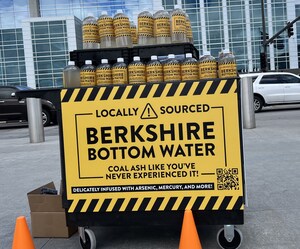Iowa Utilities Board Publishes Secret MidAmerican Studies on Clean Energy Transition
Internal utility studies show solar is most economical path to 100% clean energy
DES MOINES, Iowa, Feb. 21, 2023 /PRNewswire/ -- In response to an Iowa Utilities Board Order, MidAmerican Energy filed new public versions of two internal studies that show solar is the lowest cost path for achieving carbon free energy and recognize that transitioning away from burning coal is an essential piece of achieving this goal. The studies also raise questions about the economics of MidAmerican's coal fleet. Despite its own studies' findings, MidAmerican has not announced plans to retire any of its coal plants. In the current Wind PRIME proposal before the IUB, MidAmerican has proposed to build 40 times more wind than solar and to continue to operate its coal plants long-term. MidAmerican is one of the top 10 largest coal fleet owners in the country without a plan for retirement of those plants by 2035.
MidAmerican initially refused to provide the studies even to the Iowa Utilities Board, then sought to hold the studies confidential in their entirety. MidAmerican then released new redacted versions of the studies after the IUB stated they would become public in response to a motion by the Environmental Law & Policy Center (ELPC), the Iowa Environmental Council (IEC), and the Sierra Club that argued the public should see the studies before the IUB makes a decision whether to approve MidAmerican's pending $3.9 billion Wind PRIME project.
The IUB determined the studies had significant importance to Iowa customers, stating "It is difficult to imagine a more impactful decision to the Iowa ratepayers within MidAmerican's monopoly service area than a multibillion-dollar, long-term capital investment strategy for the provision of electric generation assets." The Board concluded that "there is significant public purpose and interest in the disclosure of the Non-Confidential Information."
Environmental groups sought release of the studies to make sure the public had an opportunity to compare MidAmerican's internal findings with its public positions concerning the clean energy transition. "MidAmerican needs to be honest with its customers," said Josh Mandelbaum, Senior Attorney at ELPC. "MidAmerican has asserted that Wind PRIME is about meeting strong customer demand for carbon free electricity. But the company's own studies show that in order to deliver carbon free electricity, the utility knows it must transition away from burning coal, and that solar and battery storage are key to that transition."
MidAmerican's 2019 "Zero Emissions Study" assessed how to "achieve zero emissions for MidAmerican's Iowa/South Dakota resource mix from both a resource adequacy and cost-effectiveness standpoint." MidAmerican considered scenarios based on retiring its coal and gas generation in either 2021 or 2040, concluding that "In all retirement scenarios studied, solar photovoltaic (solar PV) replacements provide the lowest cost zero emissions solution."
The Zero Emissions Study noted that future electric generation would be needed because "on-peak periods, particularly in the summer months, have shortfalls." Due to the timing of shortfalls, the study concluded that "solar and storage are good candidates to provide the required energy as summer on-peak energy is the primary need." In contrast, MidAmerican's Wind PRIME project would add 2,042 megawatts (MW) of wind, but only 50 MW of solar and zero battery storage.
The Zero Emissions Study also identified that the Louisa and Ottumwa coal plants are not profitable.
In the second study, MidAmerican hired Siemens AG in 2020 to conduct a Coal Plant Economics Assessment, which compared the costs of running MidAmerican's coal plants to the costs of buying energy on the regional market. The study concluded that Ottumwa Generating Station was "a retirement candidate under the base [MidAmerican] load" that should retire in 2026 or 2027. Under its base case, it also found that George Neal 3 (Sioux City) was uneconomic by 2033. It concluded that coal plants were often more expensive than market prices, so they should run less in scenarios of the future: "George Neal units 3 and 4 demonstrated the lowest utilization followed by Ottumwa and Louisa."
Neither study used standard industry best practices for studying the cost effectiveness of existing generation or planning for new generation. The Zero Emissions Study identified using a standard industry modeling tool to optimize cost effective resource additions as a next step. MidAmerican did not use this tool to develop its Wind PRIME proposal, despite having done so in past cases.
"MidAmerican customers should be asking why their utility is not following the recommendations of its own internal experts to reliably and cost-effectively reach 100% carbon free energy," said Laurie Williams from Sierra Club. "Refusing to plan for a system to replace increasingly uneconomic coal is irresponsible."
For testimony in the Wind PRIME case, ELPC, IEC, and Sierra Club hired independent modeling experts from Synapse Energy Economics and Energy Futures Group to conduct the type of analysis recommended in MidAmerican's Zero Emissions Study. These experts concluded that building a mix of wind, solar, and storage and planning for the phased retirement of MidAmerican's coal fleet by 2035 would save customers $120 million. That's compared to MidAmerican's plan to add 2,000 megawatts of wind, only 50 megawatts of solar, no battery storage, and to continue to operate all of its coal generation.
"It is telling that MidAmerican's analysis found that solar investments are best for customers even before the availability of the incentives in the Inflation Reduction Act that make solar look even better from an economic standpoint," said Michael Schmidt, Staff Attorney at IEC. "Coal plant economics are plummeting. The IRA incentivizes investment in coal plant communities to transition workers and buffer local tax impacts that result from plant closures. It is crucial that MidAmerican take that into consideration now, not after investing $4 billion of its customers' money in the wrong types of generation."
The Iowa Utilities Board is scheduled to conduct a hearing on the Wind PRIME docket beginning February 20, 2023, during which MidAmerican Energy executives and other parties in the docket will provide testimony. Following the hearing, the IUB will make its determination whether to approve the Wind PRIME proposal.
SOURCE Iowa Environmental Council

WANT YOUR COMPANY'S NEWS FEATURED ON PRNEWSWIRE.COM?
Newsrooms &
Influencers
Digital Media
Outlets
Journalists
Opted In






Share this article